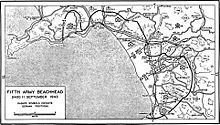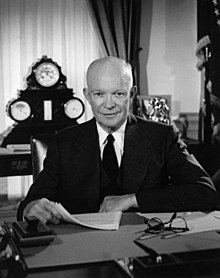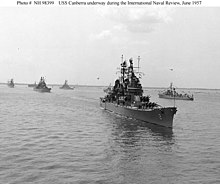Jerauld Wright
Upon his retirement from the navy, Wright subsequently served on the Central Intelligence Agency's National Board of Estimates (NBE) and as the United States Ambassador to the Republic of China (Taiwan).
[9]Prior to going to the United States Naval Academy in Annapolis, Maryland, Wright attended the Franciscan Coligio de La Salle in Malate, California, and Shadman's School at Scott's Circle in Washington, DC.
Dyer showed the flag in port visits to Gibraltar, La Spezia, Venice, Trieste, Spoleto, Corfu, and Constantinople during a nine-month cruise of the Mediterranean following the signing of the Armistice ending World War I.
[15] Lt. Wright also briefly commanded the Paul Jones, a Clemson-class destroyer, which escorted the presidential yacht Mayflower, with President Warren G. Harding on board, from Gardiner's Bay, New York, to the Capes.
[16] In October 1920, Lt. Wright took command of USS Reid, Clemson-class destroyer anchored in reserve at Naval Station Newport, Rhode Island, for transfer to Charleston, South Carolina.
[25] Wright served as a naval aide for two Presidents of the United States, including Calvin Coolidge from September 1924 to June 1926, with additional duties as a watch and division officer on board the presidential yacht Mayflower,[26] and Herbert Hoover during his pre-inaugural goodwill tour of Latin America in November 1928.
[36] The USS Mississippi completed its overhaul in three weeks and transited the Panama Canal to re-join the U.S. Pacific Fleet, visiting San Francisco, California to re-assure its citizens in the aftermath of the attack on Pearl Harbor.
On October 16, 1942, Captain Jerauld Wright was summoned to Operation Torch's staff headquarters at Norfolk House in London for an important meeting with General Eisenhower, alongside other senior officers.
[40] The group flew in two Boeing B-17 Flying Fortress bombers to Gibraltar, and on October 19, they boarded the British submarine HMS Seraph, Lieutenant Norman Limbury Auchinleck "Bill" Jewell, RN, commanding.
Wright met with Capitaine de vaisseau Jean Barjot and learned that the French Navy was opposed to U.S. entry into North Africa, although the army and air force supported it.
[43] With the preliminaries concluded during Operation Flagpole, the next task was to free Général Giraud (code-named Kingpin) whom the Vichy government had under house arrest for his anti-Nazi leanings at Toulon in southern France.
However, the most significant development was on the diplomatic and political front when U.S. consul general Robert D. Murphy alerted the Allied high command about the unexpected presence of Admiral de la flotte Jean Darlan, the head of the Vichy French military, who was visiting his ill son in Algiers.
[48]Admiral Harold R. Stark noted in Wright's December 1942 fitness report that: An officer of great ability, whose calm, assured habit of command inspires confidence alike in seniors and subordinates.
Finally, Admiral Darlan was assassinated on December 24, 1942, and Charles de Gaulle would ultimately outmaneuver and marginalize Henri Giraud to become the sole leader of the Free French movement.
Task Force 82 (code name DIME) under Rear Admiral John L. Hall, Jr. was to land 1st Infantry Division, Major General Terry de la Mesa Allen commanding, on beaches near Gela.
"[54] On the other hand, two developments were welcomed by Wright and his fellow invasion planners, including U.S. escort aircraft carriers (CVE) which would provide much needed off-shore close air support for the landing force, and the news that Major General E. J.
[54] September 9, 1943 was D-Day for Operation Avalanche as the 36th Infantry Division, under the command of Major General Fred L. Walker USA, stormed ashore at Salerno under heavy fire from German tanks, artillery, and machine guns.
[64] On June 15, 1944, Santa Fe participated in landings on Saipan, Guam, and Tinian (Operation Forager) as a part of the United States Fifth Fleet under the overall command of Vice Admiral Raymond A. Spruance.
[66] Later, on June 20, Santa Fe ignored possible Japanese submarine activity when she turned on her lights to help guide returning American aircraft back to their carriers during highly hazardous night landings.
PORTREX was the largest peacetime amphibious exercise up to that time and it was staged to evaluate joint doctrine for combined operations, test new equipment under simulated combat conditions and provide training for the defense of the Caribbean.
[84][85] Wright's operational control over the Sixth Fleet proved to be a source of friction with Admiral Lord Louis Mountbatten, RN, NATO's Commander-in-Chief Allied Forces Mediterranean (CINCAFMED).
He made a 14-day goodwill trip to the Middle East that culminated with a courtesy call with the newly crowned King Saud bin Abdul Aziz in Jidda, Saudi Arabia.
Central Intelligence Agency Director Allen Dulles was reported to have said that ten missile-carrying Soviet submarines could destroy 1600 square miles (4144 km2) of the industrial-rich eastern seaboard in a sneak attack.
[105] Chief of Naval Operations (CNO) Arleigh A. Burke had responded on April 1 by creating Task Force Alfa, a hunter-killer (HUK) flotilla under the command of Rear Admiral John S. Thach, which would develop new ASW tactics to counter this growing Soviet submarine threat.
[108] The efforts of the Atlantic Fleet to develop and implement new ASW tactics during Admiral Wright's tour of duty laid the groundwork for the success that the U.S. Navy had in locating and tracking Soviet submarines during the Cuban Missile Crisis.
[110] The White House announced on December 31, 1959, that Admiral Jerauld Wright was stepping down as CINCLANTFLT/CINCLANT/SACLANT, with President Dwight D. Eisenhower reflecting wider sentiment when he noted: I would like to take this opportunity to express my personal thanks and that of the American people for the services which you have performed over a period of the last six years.
[112] Admiral Wright received a second Distinguished Service Medal in recognition of his six-year as CINCLANTFLT/CINCLANT/SACLANT from Secretary of the Navy William B. Franke in a special ceremony held on board the supercarrier USS Independence.
As a member of the advanced party which effected a successful night landing along the northern coast of the continent and kept a secret rendezvous prior to the outbreak of hostilities, Captain Wright participated in vital conferences preliminary to the invasion of Morocco and Algeria.
Skilled and courageous in directing his command in its assigned missions to protect the withdrawal of two severely damaged ships from enemy infested waters, Rear Admiral Wright contributed essentially to the expeditious accomplishment of his hazardous salvage operation, providing efficient and effective support against hostile air attacks and making possible the successful reclamation of the damaged ships ...[46]For meritorious service of a high degree in connection with a mission by submarine to Algeria, and negotiations with the French near that city prior to the occupation of North Africa by Allied Forces.
[129] Wright was a long-time member of the United States Naval Institute, serving as its president from 1959 to 1960 and was a frequent contributor to its Proceedings, including an insightful December 1951 article on the challenges facing the newly created NATO.























